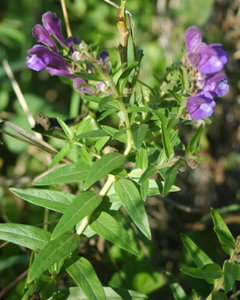
Pinyin: Huang Qin Latin: Scutellaria Baicalensis
Common Names
Baikal Skullcap, Huang Qin, Mad Dog Herb, Helmet Flower, Hoodwort, Quaker Bonnet, Ou Gon
Physical Characteristics
Perennial growing to 0.3m by 0.3m. It is hardy to zone 5. It is in flower in August, and the seeds ripen in September. The flowers are hermaphrodite (have both male and female organs) and are pollinated by Insects. The plant prefers light (sandy) and medium (loamy) soils and requires well-drained soil. The plant prefers acid, neutral and basic (alkaline) soils. It can grow in semi-shade (light woodland) or no shade. It requires dry or moist soil.
Family
Edible Uses*
Edible Parts: Leaves. Edible Uses: Tea. Young leaves - cooked as a vegetable. The whole plant is dried and used as a tea substitute.*
Traditional Chinese Medicinal (TCM) Uses*
Anodyne; Antibacterial; Anticholesterolemic; Antipyretic; Antispasmodic; Astringent; Cholagogue; Diuretic; Expectorant; Febrifuge; Haemostatic; Laxative; Nervine; Sedative; Stomachic; TB; Tonic. Baikal skullcap is commonly used in Chinese herbalism, where it is considered to be one of the 50 fundamental herbs and is used primarily in treating "hot and damp" conditions such as dysentery and diarrhea. It has been used medicinally for over 2,000 years and recent research has found that the roots contain flavonoids that greatly enhance liver function and also have anti-inflammatory and antiallergenic effects. The root is anodyne, antibacterial, anticholesterolemic, antipyretic, antispasmodic, astringent, cholagogue, diuretic, expectorant, febrifuge, haemostatic, laxative, nervine, mildly sedative, stomachic and tonic (for TB). It reputedly calms the foetus in pregnant women. The root is used internally in the treatment of enteritis, dysentery, diarrhoea, jaundice, chronic hepatitis, urinary tract infections, hypertension, threatened miscarriage, nosebleed and haemorrhage from the lungs or bowel. It is one of the ingredients of the Chinese drug 'injection of three yellow herbs'. The root is harvested in the autumn or spring from plants 3 - 4 years old and is dried for later use. The seed is used to cleanse the bowels of blood and pus.*
Other purported uses: Atherosclerosis, Cancer treatment, Epilepsy, Hepatitis, Infections, Inflammation, Insomnia.*
References
Sources: Scutellaria Baicalensis Plants for a Future
Scutellaria Baicalensis Sloan Kettering Cancer Center
Natural dietary supplements are designed to offer the body support to promote health, harmony, balance and overall well being.*

 Get Well Natural, LLC
Get Well Natural, LLC  Kidney Function & Regeneration Health
Kidney Function & Regeneration Health  Platelet & Blood Cell Health
Platelet & Blood Cell Health  Prostate, Flow & Function Health
Prostate, Flow & Function Health  General Mind & Body Health
General Mind & Body Health  Heart, Cholesterol & Cardio Health
Heart, Cholesterol & Cardio Health  Allergy-Free Body
Allergy-Free Body  Anxiety & Stress
Anxiety & Stress  Blood Platelet Counts & Function
Blood Platelet Counts & Function  Blood Pressure Health
Blood Pressure Health  Kidney Health
Kidney Health  Immune System Health & Balance
Immune System Health & Balance  Prostate & Urinary Health Function
Prostate & Urinary Health Function  Blood Sugar Balance
Blood Sugar Balance  Cardiovascular Heart Health
Cardiovascular Heart Health  Detoxification & Healthy Cells
Detoxification & Healthy Cells  Women's Health
Women's Health  Liver Regeneration
Liver Regeneration  Pain-Free Body
Pain-Free Body  Water & Air Filtration
Water & Air Filtration 


